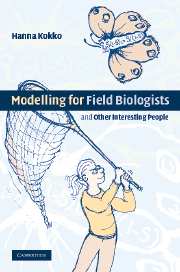Book contents
- Frontmatter
- Contents
- Preface
- 1 Modelling philosophy
- 2 Population genetics
- 3 Quantitative genetics
- 4 Optimization methods
- 5 Dynamic optimization
- 6 Game theory
- 7 Self-consistent games and evolutionary invasion analysis
- 8 Individual-based simulations
- 9 Concluding remarks
- Appendix: A quick guide to MATLAB
- References
- Index
4 - Optimization methods
Published online by Cambridge University Press: 05 June 2012
- Frontmatter
- Contents
- Preface
- 1 Modelling philosophy
- 2 Population genetics
- 3 Quantitative genetics
- 4 Optimization methods
- 5 Dynamic optimization
- 6 Game theory
- 7 Self-consistent games and evolutionary invasion analysis
- 8 Individual-based simulations
- 9 Concluding remarks
- Appendix: A quick guide to MATLAB
- References
- Index
Summary
where spiders get quite exhausted, and the author confesses an
embarrassing mistake from the distant past
In the previous chapter, the evolutionary endpoint was one where the selection differential S ‘vanished’, which is jargon and means that it became zero: no further selection is then operating. The value of z that made S vanish was the one that made the derivative of fitness equal zero. Why did we calculate derivatives of fitness there? The derivative is something about how steeply a function increases (positive derivative) or decreases (negative derivative). This means that derivatives are very handy for finding out where bigger values of something can be found: just follow the uphill slope until … it turns negative, oops, now go no further. If we are dealing with a nice smooth function (there is some mathematical terminology for this, but just imagine something that bends gently without sharp edges), the ‘uphill’ part of the slope means a positive derivative (Fig. 4.1), and the point where uphill turns into downhill is where the derivative passes through zero on its way from positive to negative. In other words: where the derivative is zero, we have a good candidate for a local maximum of the function we were interested in.
So, the point where the selection differential S reached the value zero, also happened to maximize W. This is not a coincidence since S was indeed proportional to the partial derivative ∂W/∂z.
Information
- Type
- Chapter
- Information
- Publisher: Cambridge University PressPrint publication year: 2007
